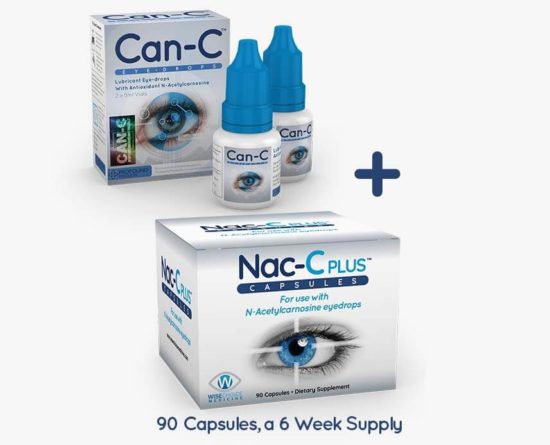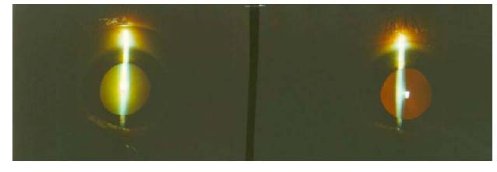April is Women's Eye Health and Safety Month - click here for FREE healthy vision tips
Menu


Dr. Mark Babizhayev, a leading biophysicist in the area of natural peptides and their unique ability to reverse oxidation has developed and patented this specific oral formulation to effectively sustain the activity of Can-C eye drops for longer periods within the eye tissues.
When taken consistently with Can-C eye drops, Nac-C Plus increases the length of time that the Can-C eye drops remain active in the eye, by preventing and slowing the break down of carnosine once it has been topically delivered. This sustaining action greatly improves free radical protection and further reduces the oxidative environment within the eye allowing for an accelerated healing response.
We know that Can-C™ eye drops are highly effective on their own and are a stand alone product for the reversal of many ocular conditions. Nac-C Plus™ is a complementary supplement for those who want to maximize their effort with the use of Can-C™ eye drops. In addition, those who have more mature cataract with measurably diminished vision will greatly optimize their effort by taking Nac-C Plus in addition to their daily applications of Can-C™ eye-drops.
Nac-C Plus has been formulated, approved and patented by the inventors of the Can-C eye-drop technology. Designed to be used with Can-C eye-drops, Nac-C Plus™ taken orally helps to support the effectiveness and optimize the action of Can-C eye drops.
With the knowledge that there is a natural range of the histidyl dipeptides within mammalian tissues we have investigated possible synergism between them in respect of antioxidant activity in ophthalmic treatments.
Considering the efficacy of N-acetylcarnosine eye drops in the therapeutic treatment of ripe cataracts, we now theorize that, declining visual acuity, along with the onset of ‘halo’ effects and vitreous lesions, including floaters and even elevated IOP, may be a result of diminished Glutathione levels within the eye.
“New research supports the protective effect of vitamin E, N-acetylcysteine as well as mitochondrial permeability transition (MPT) inhibitors in the management POAG” Dr. Yuan He more information In a separate pilot study, ripe, human, age-related, cataract is significantly reversed over a period of 5 months, with the application of Can-C™ N-acetylcarnosine eye drops (2 drops twice daily) combined with Nac-C Plus™, 1 tablet (two times daily).
We found that the L-Histidine ingredient in the Nac-C Plus formulation acts synergistically with other natural imidazole containing Peptidomimetics (N-acetylcarnosine, L-carnosine) as antioxidants. Our results show that combining imidazole containing compounds at near physiological concentrations results in heightened synergistic anti-oxidant activity. The clinical and experimental data demonstrate the improved effectiveness and safety of the combined treatment modality.
The oral consumption of the N-acetyl-cysteine ingredient in Nac-C Plus, boosts reduced glutathione levels in the human crystalline lens. As indicated in the Figure 1, ripe age-related cataract is significantly reversed within 5 months of combined treatment.

Figure 1:
Left image: pronounced opacities in the lens layers prior cataract treatment;
Right image: An appearance of the rose reflex visible through the lens which became significantly more transparent after 5 months of combined treatment of cataract with the N-acetylcarnosine eye drop combined with the oral supplementation of Nac-C Plus.Conclusion: Manipulation with chemical chaperones; N-acetylcarnosine, carnosine, D- pantethine or regulated/inducible molecular chaperone protein function (such as alpha-crystallin chaperone activity in the lens) offers novel therapies for reversal of (ripe) cataracts, retinal degeneration and ocular complications of diabetes.
Other Ingredients: Micro-crystalline Cellulose, Di Basic Calcium Phosphate, Magnesium Stearate, Aerosil, Vegetarian Capsule.
Shown to reduce cataract risk, Vitamin E (AKA alpha-tocopherol) is a fat-soluble antioxidant found in the membranes and lens fibers of the eye. It is thought to reduce degradation of lens lipids and stabilize the cell membranes of the lens, thereby protecting against cataracts. Several studies have demonstrated that low vitamin E levels are associated with increased cataract risk(1) while higher vitamin E consumption protects against cataract formation.(2)
Zinc is vital to keeping your eyes healthy and vision sharp. Zinc is concentrated in a part of the retina called the “macula” and helps Vitamin A produce melanin, a pigment which has a protective effect on the eye. A deficiency in zinc has been associated with reduced night vision, while supplementation with zinc has been shown to slow the rate of age-related macular degeneration due to its importance in maintaining a healthy macula.(1) Zinc has also been shown to reduce cataracts by as much as 36% in people ages 65-74.(2)
Glutathione is especially concentrated in the lens of the eye, and when it is depleted due to aging or oxidative stress it can cause cataract formation.(1, 2) That’s because glutathione is key to protecting lens flexibility and clarity, acting as a very powerful antioxidant to shield proteins and enzymes from oxidative stress caused by free radicals.(3) That means glutathione is something we want more of. Orally-administered N-Acetyl-Cysteine supports the glutathione sparing effects of Can-C™ eye drops and further increases tissue glutathione levels in the eye.
L-Histidine works synergistically with L-Carnosine and N-Acetylcarnosine to create heightened antioxidant activity, thereby protecting the eye from cataract-causing damage.(1) Clinical trials have shown that adding L-Histidine to other “natural imidazole-containing Peptidomimetics” like the ones mentioned above leads to a demonstrable increase in the treatment’s effectiveness and safety.(2, 3)
Cataracts tend to result from oxidative stress, and L-Carnosine has been shown to have an antioxidant impact on a cataract-affected lens, enhancing DNA repair and helping to prevent DNA strand breaks caused by UV radiation.(1)
L-Carnosine has been shown in clinical trials to be highly effective at protecting against and/or reversing cataracts, improving vision and quality of life.(2, 3) In fact, according to a Chinese trial on 96 patients aged 60 or older, Carnosine has a significant effect on primary senile cataracts, with a 100% effective rate. The impact rate for mature senile cataracts was 80%.(4)
D-Pantethine works synergistically with N-Acetyl-Carnosine and L-Carnosine to help reverse cataracts, retinal degeneration, and ocular complications of diabetes.(1)
L-Methionine is an essential amino acid naturally synthesized in the body after protein consumption, and is a precursor to the creation of other amino acids that support eye health like taurine, carnitine, and cysteine. It is found naturally in egg whites, fish, poultry, and seaweed, among other foods.
When combined with adequate amounts of B vitamins, L-Methionine can help reduce homocysteine levels, relieving glaucoma, macular degeneration, and other retinal conditions, as well as detoxifying the body.(1, 2)
Nac-C Plus tablets previously named Can-C Plus, are now available in US and European Markets
Patents: (WO 2004/028536 A1; WO 94/19325; WO 95/12581; WO 2004/064866 A1)
Related Articles:
Free shipping on all US orders
Your data is safe
Satisfaction guaranteed
Email support is always available

*Disclaimer: The above statements have not been evaluated by the FDA. They are not intended to diagnose, treat, cure or prevent any disease or condition.
If you have a health condition or concern, consult a physician or your alternative health care provider.
Always consult a medical doctor before modifying your diet, using any new product, drug, supplement, or doing new exercises.
Use of this site constitutes acceptance of our Shipping and Returns Policy, our Terms and Conditions and our Privacy & Cookies Policy
| Cookie | Duration | Description |
|---|---|---|
| cookielawinfo-checkbox-analytics | 11 months | This cookie is set by GDPR Cookie Consent plugin. The cookie is used to store the user consent for the cookies in the category "Analytics". |
| cookielawinfo-checkbox-functional | 11 months | The cookie is set by GDPR cookie consent to record the user consent for the cookies in the category "Functional". |
| cookielawinfo-checkbox-necessary | 11 months | This cookie is set by GDPR Cookie Consent plugin. The cookies is used to store the user consent for the cookies in the category "Necessary". |
| cookielawinfo-checkbox-others | 11 months | This cookie is set by GDPR Cookie Consent plugin. The cookie is used to store the user consent for the cookies in the category "Other. |
| cookielawinfo-checkbox-performance | 11 months | This cookie is set by GDPR Cookie Consent plugin. The cookie is used to store the user consent for the cookies in the category "Performance". |
| viewed_cookie_policy | 11 months | The cookie is set by the GDPR Cookie Consent plugin and is used to store whether or not user has consented to the use of cookies. It does not store any personal data. |
Any questions? We’re here to help.